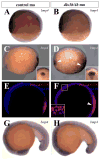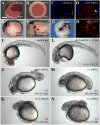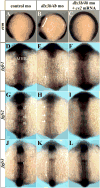dlx3b/4b are required for the formation of the preplacodal region and otic placode through local modulation of BMP activity
- PMID: 19007769
- PMCID: PMC2674874
- DOI: 10.1016/j.ydbio.2008.10.017
dlx3b/4b are required for the formation of the preplacodal region and otic placode through local modulation of BMP activity
Abstract
The vertebrate inner ear arises from the otic placode, a transient thickening of ectodermal epithelium adjacent to neural crest domains in the presumptive head. During late gastrulation, cells fated to comprise the inner ear are part of a domain in cranial ectoderm that contain precursors of all sensory placodes, termed the preplacodal region (PPR). The combination of low levels of BMP activity coupled with high levels of FGF signaling are required to establish the PPR through induction of members of the six/eya/dach, iro, and dlx families of transcription factors. The zebrafish dlx3b/4b transcription factors are expressed at the neural plate border where they play partially redundant roles in the specification of the PPR, otic and olfactory placodes. We demonstrate that dlx3b/4b assist in establishing the PPR through the transcriptional regulation of the BMP antagonist cv2. Morpholino-mediated knockdown of Dlx3b/4b results in loss of cv2 expression in the PPR and a transient increase in Bmp4 activity that lasts throughout early somitogenesis. Through the cv2-mediated inhibition of BMP activity, dlx3b/4b create an environment where FGF activity is favorable for PPR and otic marker expression. Our results provide insight into the mechanisms of PPR specification as well as the role of dlx3b/4b function in PPR and otic placode induction.
Figures









Similar articles
-
Fgf-dependent otic induction requires competence provided by Foxi1 and Dlx3b.BMC Dev Biol. 2007 Jan 19;7:5. doi: 10.1186/1471-213X-7-5. BMC Dev Biol. 2007. PMID: 17239227 Free PMC article.
-
Zebrafish Foxi1 provides a neuronal ground state during inner ear induction preceding the Dlx3b/4b-regulated sensory lineage.Development. 2013 May;140(9):1936-45. doi: 10.1242/dev.087718. Development. 2013. PMID: 23571216
-
dlx3b and dlx4b function in the development of Rohon-Beard sensory neurons and trigeminal placode in the zebrafish neurula.Dev Biol. 2004 Dec 15;276(2):523-40. doi: 10.1016/j.ydbio.2004.09.020. Dev Biol. 2004. PMID: 15581883 Free PMC article.
-
Establishing the pre-placodal region and breaking it into placodes with distinct identities.Dev Biol. 2014 May 1;389(1):13-27. doi: 10.1016/j.ydbio.2014.02.011. Epub 2014 Feb 24. Dev Biol. 2014. PMID: 24576539 Free PMC article. Review.
-
The preplacodal region: an ectodermal domain with multipotential progenitors that contribute to sense organs and cranial sensory ganglia.Int J Dev Biol. 2007;51(6-7):447-61. doi: 10.1387/ijdb.072327as. Int J Dev Biol. 2007. PMID: 17891708 Review.
Cited by
-
Differential BMP signaling controls formation and differentiation of multipotent preplacodal ectoderm progenitors from human embryonic stem cells.Dev Biol. 2013 Jul 15;379(2):208-20. doi: 10.1016/j.ydbio.2013.04.023. Epub 2013 Apr 30. Dev Biol. 2013. PMID: 23643939 Free PMC article.
-
Transcriptional regulation of cranial sensory placode development.Curr Top Dev Biol. 2015;111:301-50. doi: 10.1016/bs.ctdb.2014.11.009. Epub 2015 Jan 22. Curr Top Dev Biol. 2015. PMID: 25662264 Free PMC article. Review.
-
Pax2 and Pea3 synergize to activate a novel regulatory enhancer for spalt4 in the developing ear.Dev Biol. 2010 Apr 15;340(2):222-31. doi: 10.1016/j.ydbio.2009.11.004. Epub 2009 Nov 10. Dev Biol. 2010. PMID: 19913005 Free PMC article.
-
Building the Border: Development of the Chordate Neural Plate Border Region and Its Derivatives.Front Physiol. 2020 Dec 7;11:608880. doi: 10.3389/fphys.2020.608880. eCollection 2020. Front Physiol. 2020. PMID: 33364980 Free PMC article. Review.
-
Mesendodermal signals required for otic induction: Bmp-antagonists cooperate with Fgf and can facilitate formation of ectopic otic tissue.Dev Dyn. 2009 Jun;238(6):1582-94. doi: 10.1002/dvdy.21955. Dev Dyn. 2009. PMID: 19418450 Free PMC article.
References
-
- Acampora D, Merlo GR, Paleari L, Zerega B, Postiglione MP, Mantero S, Bober E, Barbieri O, Simeone A, Levi G. Craniofacial, vestibular and bone defects in mice lacking the Distal-less-related gene Dlx5. Development. 1999;126:3795–809. - PubMed
-
- Ahrens K, Schlosser G. Tissues and signals involved in the induction of placodal Six1 expression in Xenopus laevis. Dev Biol. 2005;288:40–59. - PubMed
-
- Aybar MJ, Mayor R. Early induction of neural crest cells: lessons learned from frog, fish and chick. Curr Opin Genet Dev. 2002;12:452–8. - PubMed
-
- Bailey AP, Streit A. Sensory organs: making and breaking the pre-placodal region. Curr Top Dev Biol. 2006;72:167–204. - PubMed
Publication types
MeSH terms
Substances
Grants and funding
LinkOut - more resources
Full Text Sources
Molecular Biology Databases

